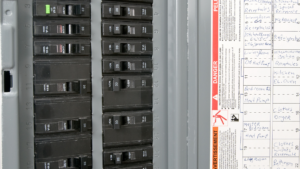
Types of Circuit Breakers
Single-Pole Circuit Breakers
Specifications and Use: Single-pole circuit breakers are the most common type used in residential electrical panels. They are designed to protect one energized wire and provide 120 volts to a circuit. These breakers are typically rated for 15 to 20 amps.
Best Use: Single-pole breakers are ideal for standard household circuits, such as lighting fixtures, outlets, and small appliances. They are suitable for circuits that require a lower voltage and are not prone to high current demands.
Benefits:
- Ease of Installation: Single-pole breakers are easy to install and replace.
- Cost-Effective: They are generally more affordable than other types of breakers.
- Reliability: These breakers are highly reliable for everyday household use.
Double-Pole Circuit Breakers
Specifications and Use: Double-pole circuit breakers protect two energized wires and provide 240 volts to a circuit. They can handle amperage ratings ranging from 15 to 200 amps, making them suitable for more demanding electrical loads.
Best Use: Double-pole breakers are used for larger appliances and systems, such as water heaters, air conditioners, electric dryers, and subpanels. They are essential for circuits that require higher voltage and amperage.
Benefits:
- Higher Capacity: Double-pole breakers can handle larger electrical loads, making them suitable for high-power appliances.
- Safety: By interrupting both wires simultaneously, they provide better protection against electrical faults.
- Versatility: They are used in both residential and commercial applications.
GFCI Circuit Breakers
Specifications and Use: Ground Fault Circuit Interrupter (GFCI) breakers are designed to protect against ground faults, which occur when electrical current flows outside its intended path, such as through water or a person. GFCI breakers detect ground faults and interrupt the circuit to prevent shock.
Best Use: GFCI breakers are required in areas with high moisture levels, such as bathrooms, kitchens, garages, and outdoor locations. They are essential for any location where electrical outlets are near water sources.
Benefits:
- Enhanced Safety: GFCI breakers significantly reduce the risk of electrical shock and are critical for protecting human life.
- Code Compliance: They are required by electrical codes in many areas, ensuring regulatory compliance.
- Peace of Mind: Knowing that these breakers provide extra protection in high-risk areas adds an extra layer of security.
AFCI Circuit Breakers
Specifications and Use: Arc Fault Circuit Interrupter (AFCI) breakers are designed to detect and interrupt arc faults, which occur when electrical arcs (sparks) form due to damaged, corroded, or loose connections. These arcs can cause fires if left unchecked.
Best Use: AFCI breakers are ideal for living areas, bedrooms, and other spaces where electrical wiring may be subject to damage or wear over time. They are increasingly being mandated by building codes for new constructions and renovations.
Benefits:
- Fire Prevention: By detecting and interrupting arc faults, AFCI breakers help prevent electrical fires.
- Advanced Protection: They offer a higher level of protection compared to standard breakers, safeguarding both property and lives.
- Building Code Compliance: As more jurisdictions require AFCI protection, using these breakers ensures compliance with current standards.
Fuse Box vs. Breaker Box
Fuse Box: A fuse box uses fuses to protect electrical circuits. When a fault occurs, the fuse blows (melts) and needs to be replaced. Fuse boxes were more commonly used in older homes.
Advantages:
- Cost: Fuses are generally cheaper than breakers.
- Simplicity: Fuse boxes are straightforward and easy to understand.
Disadvantages:
- Replacement: Fuses must be replaced after they blow, which can be inconvenient.
- Limited Capacity: Fuse boxes are less capable of handling modern electrical loads and are often not up to current safety standards.
Breaker Box: A breaker box uses circuit breakers to protect electrical circuits. When a fault occurs, the breaker trips and can be reset rather than replaced. Breaker boxes are standard in modern homes.
Advantages:
- Convenience: Breakers can be easily reset, saving time and effort.
- Higher Capacity: Breaker boxes can handle higher electrical loads and offer more protection features, such as GFCI and AFCI breakers.
- Safety: Breaker boxes meet modern safety standards and provide better overall protection.
Disadvantages:
- Cost: Breakers and breaker boxes can be more expensive than fuses and fuse boxes.
Understanding the different types of circuit breakers and their applications is crucial for maintaining a safe and efficient electrical system. Single-pole and double-pole breakers serve standard and high-power circuits, respectively, while GFCI and AFCI breakers offer specialized protection against ground faults and arc faults.
Additionally, upgrading from a fuse box to a breaker box can provide enhanced safety, convenience, and compliance with modern electrical codes. By choosing the right circuit breaker for each application, you can ensure the long-term reliability and safety of your electrical system.
Save Money On Electrical Repairs with Agway EnergyGuard™
Circuit breakers protect your home from the dangers of overcurrent, a common side effect of poor or degraded wiring. As home age, the risk of a short or overload increases, which can cost hundreds of dollars to repair. Home insurance doesn’t protect against this type of damage, but Agway does. Our EnergyGuard™ Home Repair Program provides comprehensive coverage for your heating, cooling, and electrical systems, protecting them from the wear and tear of daily use.
When a repair is needed, our customers can relax knowing they won’t have to search for a qualified technician. Simply call us, and we’ll handle the rest. We have a vast network of HVAC contractors in your area and will send the first available expert directly to your door. Plus, there are no service fees or deductibles. We cover the cost of the visit and all included parts. Don’t let a malfunction disrupt your budget. Sign up for EnergyGuard™ today and start enjoying peace of mind!